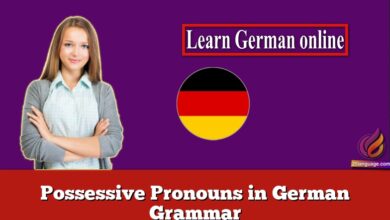Sentence structure in German

Sentence structure in German.The sentence structure is a paramount element in learning any language, serving as the foundation for conveying ideas and meanings. Understanding and grasping sentence structure depends on knowing how to arrange words, utilize tenses, verbs, and pronouns correctly.

Explanation about sentence structure in German
1. Word Order
The basic word order in German is Subject-Verb-Object, similar to English. However, German is known for its flexible word order, especially because it is a Subject-Object-Verb language in subordinate clauses.
2. Verb Position
- Main Clauses: The conjugated verb is always in the second position.
- E.g., Ich gehe ins Kino. (I am going to the cinema.)
- Subordinate Clauses: The conjugated verb moves to the end of the clause.
- E.g., Ich weiß, dass er kommt. (I know that he is coming.)
3. Time, Manner, Place
In German, the elements of a sentence are generally arranged in the following order: Time (when?), Manner (how?), and Place (where?).
- E.g., Ich gehe morgen mit dem Bus zur Arbeit. (I am going to work by bus tomorrow.)
4. Negation
Negation words such as “nicht” (not) and “kein” (no/not any) generally go to the end of the sentence or clause.
- E.g., Ich mag das Essen nicht. (I do not like the food.)
5. Separable Prefix Verbs
In German, some verbs have separable prefixes, and these prefixes move to the end of the clause in main clauses.
- E.g., Ich stehe um 7 Uhr auf. (I get up at 7 o’clock.)
6. Compound Nouns
German is known for its compound nouns, which can influence sentence structure by combining multiple concepts into one word.
- E.g., der Handschuh (the glove – hand + shoe)
Examples for using sentence structure in German
| Structure Type | Example in German | English Translation | Explanation |
|---|---|---|---|
| Basic Word Order | Ich lese ein Buch. | I am reading a book. | Subject-Verb-Object |
| Verb Position | Er isst, weil er Hunger hat. | He is eating because he is hungry. | Verb at the end in subordinate clause. |
| Time, Manner, Place | Ich gehe morgen mit dem Auto zur Schule. | I am going to school by car tomorrow. | Time (morgen) – Manner (mit dem Auto) – Place (zur Schule) |
| Negation | Wir haben kein Geld. | We have no money. | “kein” is used for negation. |
| Separable Prefix Verbs | Sie steht um 8 Uhr auf. | She gets up at 8 o’clock. | “auf” is separated and moved to the end. |
| Compound Nouns | Das Flugzeug landet. | The airplane is landing. | “Flugzeug” is a compound noun (flight + device). |
| Cases – Nominative | Der Hund spielt. | The dog is playing. | “Der Hund” is the subject in the nominative case. |
| Cases – Accusative | Ich sehe den Hund. | I see the dog. | “den Hund” is the direct object in the accusative case. |
In conclusion, sentence structure stands as a vital and fundamental component in learning and mastering any language. Familiarity with how to construct sentences and arrange words can make a significant difference in an individual’s ability to express clearly and accurately, as well as understand what is read and heard.






























